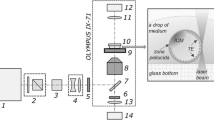Abstract
The effect of laser optical perforation of the zona pellucida on the viability and development of mouse embryos has been studied. Operations of zona pellucida thinning and single or double perforation were carried out on 2-cell embryo, morula, and blastocyst stages with a laser pulse (wavelength 1.48 µm, pulse duration 2 ms). Embryo development up to the blastocyst stage and hatching efficiency were statistically analyzed. It was found that 2-cell or morula stage embryo zona pellucida thinning or single perforation did not affect development to the blastocyst stage and number of hatched embryos, but it accelerated embryo hatching compared to control groups one day earlier in vitro. Double optoperforation on 2-cell embryo or morula stage did not significantly affect development to the blastocyst stage, but it strongly decreased the number of hatched embryos. Also, zona pellucida perforation at the blastocyst stage had a negative effect: hatching did not occur after this manipulation. Blastocyst cell number calculation after single zona pellucida perforation at 2-cell and morula stages showed that cell number of hatching or hatched blastocysts did not differ from the same control groups. This fact points out that the laser single optoperforation method is a useful and safe experimental tool that allows further manipulations within the zona pellucida.
Similar content being viewed by others
References
Mohamad, E. H., Constanze, F.-H., and Khaled, R. A. (2011) Assisted hatching in assisted reproduction: a state of the art, J. Assist. Reprod. Genet., 28, 119–128.
Cohen, J., Malter, H., Fehilly, C., Wright, G., Elsner, C., Kort, H., and Massey, J. (1988) Implantation of embryos after partial opening of oocyte zona pellucida to facilitate sperm penetration, J. Lancet, 16, 1–2.
Palanker, D., Ohad, S., Lewis, A., Simon, A., Shenkar, J., Penchas, S., and Laufer, N. (1991) Technique for cellular microsurgery using the 193-nm excimer laser, J. Lasers Surg. Med., 11, 580–586.
Tadir, Y. (1988) Ten years of laser-assisted gametes and embryo manipulation, Contemp. Obstet. Gynecol., 9, 2–10.
Cohen, J., Elsner, C., Kort, H., Malter, H., Massey, J., Mayer, M. P., and Wiemer, K. (1990) Impairment of hatching process following IVF in the human and improvement of implantation by assisted hatching using micromanipulation, J. Hum. Reprod., 5, 7–13.
Mansour, R. T., Rhodes, C. A., Aboulghar, M. A., Serour, G. I., and Kamal, A. (2000) Transfer of zona-free embryos improves outcome in poor prognosis patients: a prospective randomized controlled study, J. Hum. Reprod., 15, 1061–1064.
Primi, M. P., Senn, A., Montag, M., Van der Ven, H., Mandelbaum, J., Veiga, A., Barri, P., and Germond, M. A. (2004) European multicentre prospective randomized study to assess the use of assisted hatching with a diode laser and the benefit of an immunosuppressive/antibiotic treatment in different patient populations, J. Hum. Reprod., 19, 2325–2333.
Hurst, B. S., Tucker, K. E., Awoniyi, C. A., and Schlaff, W. D. (1998) Assisted hatching does not enhance IVF success in good-prognosis patients, J. Assist. Reprod. Genet., 15, 62–64.
Sifer, C., Sellami, A., Poncelet, C., Kulski, P., Martin-Pont, B., Bottero, J., Porcher, R., Cedrin-Durnerin, I., Hugues, J. N., and Wolf, J. P. (2006) A prospective randomized study to assess the benefit of partial zona pellucida digestion before frozen-thawed embryo transfers, J. Hum. Reprod., 21, 2384–2389.
Silfvast, W. T. (2004) in Laser Fundamentals (2nd Edn.) Cambridge, N. Y., pp. 102–103.
Hale, G. M., and Querry, M. R. (1973) Optical constants of water in the 200 nm to 200 µm wavelength region, Appl. Opt., 12, 555–563.
Tarkowski, A. K. (1966) An air-drying method for chromosome preparations from mouse eggs, Cytogenetics, 5, 394–400.
Pratt, H. P. M. (1987) in Mammalian Development: A Practical Approach (Monk, M., ed.) IRL Press, Oxford, p. 13.
Montag, M., Koll, B., Holmes, P., and van der Ven, H. (2000) Significance of the number of embryonic cells and the state of the zona pellucida for hatching of mouse blastocysts in vitro versus in vivo, J. Biol. Reprod., 62, 1738–1744.
Chailert, C., Sanmee, U., Piromlertamorn, W., Samchimchom, S., and Vutyavanich, T. (2013) Effects of partial or complete laser-assisted hatching on the hatching of mouse blastocysts and their cell numbers, J. Reprod. Biol. Endocrinol., 19, 11–21.
Balaban, B., Urman, B., Yakin, K., and Isiklar, A. (2006) Laser-assisted hatching increases pregnancy and implantation rates in cryopreserved embryos that were allowed to cleave in vitro after thawing: a prospective randomized study, J. Hum. Reprod., 21, 2136–2140.
Valojerdi, M. R., Eftekhari-Yazdi, P., Karimian, L., Hassani, F., and Movaghar, B. (2010) Effect of laser zona thinning on vitrified-warmed embryo transfer at the cleavage stage: a prospective, randomized study, J. Reprod. BioMed. Online, 20, 234–242.
Author information
Authors and Affiliations
Corresponding author
Additional information
Original Russian Text © E. O. Zakharchenko, A. D. Zalessky, A. A. Osychenko, A. S. Krivokharchenko, A. K. Shakhbazyan, A. V. Ryabova, V. A. Nadtochenko, 2015, published in Biokhimiya, 2015, Vol. 80, No. 6, pp. 911–919.
Rights and permissions
About this article
Cite this article
Zakharchenko, E.O., Zalessky, A.D., Osychenko, A.A. et al. Effect of laser optoperforation of the zona pellucida on mouse embryo development in vitro . Biochemistry Moscow 80, 769–775 (2015). https://doi.org/10.1134/S0006297915060127
Received:
Revised:
Published:
Issue Date:
DOI: https://doi.org/10.1134/S0006297915060127




